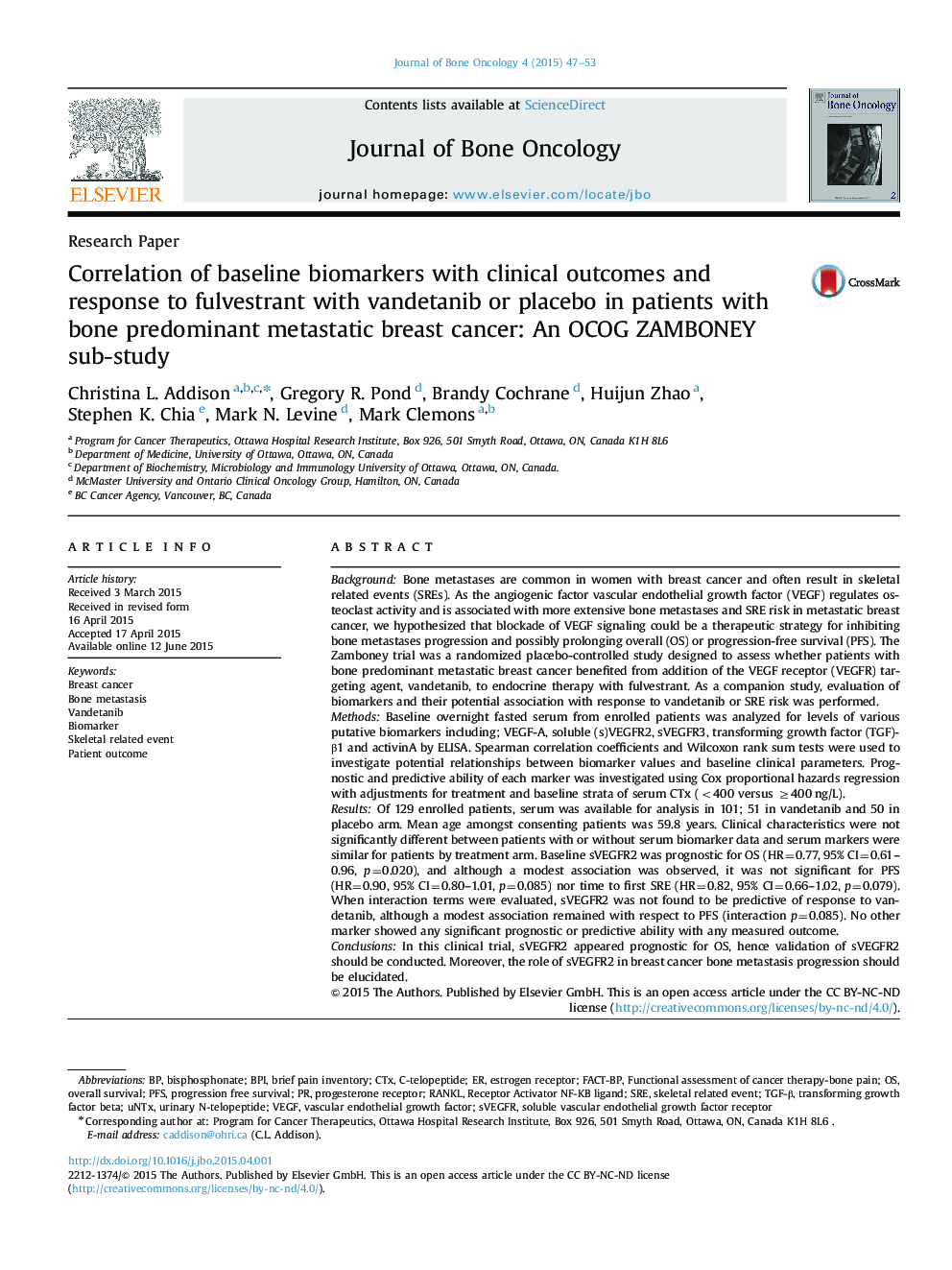| Article ID | Journal | Published Year | Pages | File Type |
|---|---|---|---|---|
| 2136148 | Journal of Bone Oncology | 2015 | 7 Pages |
•Baseline VEGF, sVEGFR3, TGF-β or activinA were not associated with clinical outcomes in patients treated with fulvestrant in conjunction with vandetanib or placebo.•Baseline sVEGFR2 was modestly associated with clinical outcomes including PFS, OS and time to first skeletal event.•Increased baseline sVEGFR2 was associated with improved clinical outcomes in this study sample.•These findings support the need for future studies of the role of sVEGFR2 in bone metastasis progression.
BackgroundBone metastases are common in women with breast cancer and often result in skeletal related events (SREs). As the angiogenic factor vascular endothelial growth factor (VEGF) regulates osteoclast activity and is associated with more extensive bone metastases and SRE risk in metastatic breast cancer, we hypothesized that blockade of VEGF signaling could be a therapeutic strategy for inhibiting bone metastases progression and possibly prolonging overall (OS) or progression-free survival (PFS). The Zamboney trial was a randomized placebo-controlled study designed to assess whether patients with bone predominant metastatic breast cancer benefited from addition of the VEGF receptor (VEGFR) targeting agent, vandetanib, to endocrine therapy with fulvestrant. As a companion study, evaluation of biomarkers and their potential association with response to vandetanib or SRE risk was performed.MethodsBaseline overnight fasted serum from enrolled patients was analyzed for levels of various putative biomarkers including; VEGF-A, soluble (s)VEGFR2, sVEGFR3, transforming growth factor (TGF)-β1 and activinA by ELISA. Spearman correlation coefficients and Wilcoxon rank sum tests were used to investigate potential relationships between biomarker values and baseline clinical parameters. Prognostic and predictive ability of each marker was investigated using Cox proportional hazards regression with adjustments for treatment and baseline strata of serum CTx (<400 versus ≥400 ng/L).ResultsOf 129 enrolled patients, serum was available for analysis in 101; 51 in vandetanib and 50 in placebo arm. Mean age amongst consenting patients was 59.8 years. Clinical characteristics were not significantly different between patients with or without serum biomarker data and serum markers were similar for patients by treatment arm. Baseline sVEGFR2 was prognostic for OS (HR=0.77, 95% CI=0.61–0.96, p=0.020), and although a modest association was observed, it was not significant for PFS (HR=0.90, 95% CI=0.80–1.01, p=0.085) nor time to first SRE (HR=0.82, 95% CI=0.66–1.02, p=0.079). When interaction terms were evaluated, sVEGFR2 was not found to be predictive of response to vandetanib, although a modest association remained with respect to PFS (interaction p=0.085). No other marker showed any significant prognostic or predictive ability with any measured outcome.ConclusionsIn this clinical trial, sVEGFR2 appeared prognostic for OS, hence validation of sVEGFR2 should be conducted. Moreover, the role of sVEGFR2 in breast cancer bone metastasis progression should be elucidated.
